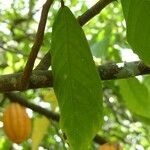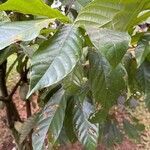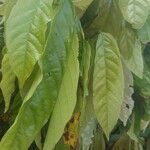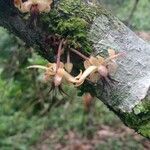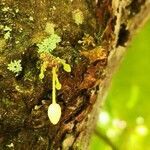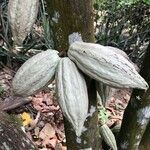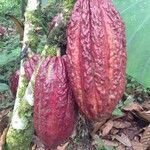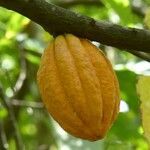Tree usually 4-8 m. high, rarely taller and up to 20 m.; growth below jorquette; primary branching quinate; young branchlets terete, grayish-green or brownish, densely or sparsely pubescent with slender, patulous, acute, simple or furcate hairs, later glabrate, rugulose and sparsely lenticellate; stipules subulate, deciduous. Leaves alternate, distichous, the petioles thickened-pulvinate at both ends, 1.5-2 (1-3) cm. long, on orthotropous stems 3-10 cm. long, pubescent or tomentose with slender, spreading, acute, simple hairs; blade subobovate-oblong or elliptic-oblong, slightly asymmetrical, rounded or obtuse at base, attenuate and acuminate at apex, entire or slightly and irregularly sinuate, 15-50 cm. long and 4-15 cm. broad, cori-aceous or chartaceous, the acumen acute or subacute and 1-2.5 mm. long; upper surface green, glabrous except for the pubescent or puberulous, prominent costa, the secondary nerves filiform; lower surface lighter green, glabrous or with very sparse, minute, simple, furcate or stellate hairs, rarely puberulous, the costa prominent, the 9-12 secondary nerves on each side prominent, subpatulous. Infiorescences on the trunk and on the branches, usually borne on small tubercles, the cymose peduncles 1-3 mm. long, stellate-pubescent, hirtellous and with scattered, glandular hairs; bracts and bracteoles ovate or ovate-oblong, acute or subacute, pubescent, deciduous; pedicels capillary, rigid, 5-15 mm. long, pale green, whitish or reddish, hirtellous with patulous, stellate or furcate hairs and glandular, capitate hairs; buds ovoid or oblong-ovoid, acute, white, whitish-green, lilac or reddish, subglabrous or sparsely puberulous. Flowers with lanceolate or oblong-lanceolate sepals, these shortly united at base, acute at apex, 5-8 mm. long and 1.5-2 mm. wide, thick-membranaceous, white, greenish-white, pale violaceous or reddish, slightly 3-nerved, glabrous or with stellate and glandular hairs outside, glabrous or with rare, glan-dular hairs inside; petals thick-membranaceous; petal-hoods obovate, rounded at apex, 3-4 mm. long and 5-2 mm. wide, white, 3-nerved; petal-laminae stipitate, the stipe linear and 2-4 mm. long, obovate or rombic-obovate, the apex attenuate, acuminate or subtruncate and shortly mucronate, rarely blunt, the margin entire or sinuate, 1.5-2.5 mm. long and 1.5-2 mm. wide, pale yellowish; staminodes nar-rowly subulate, very acute, 4-6 mm. long, the middle vein thick, angular, red or purplish, minutely papillose-pilose, the thin margin whitish, ciliate with slender, flexuose, simple hairs; filaments 1.5-2 mm. long, glabrous, 2-antheriferous; ovary glabrous or usually glandular, the glands numerous, stipitate, white or reddish, pluricellular; styles adherent, glabrous. Fruit variable in shape, from globose to fusiform and acute, with a very smooth to a strongly ridged and rugose or verrucose surface; pericarp consistently fleshy, 5-15 mm. thick, usually made of 2 more or less conspicuously different, carnose layers (epicarp and endocarp) separated by a thin, ligneous membrane (mesocarp), the latter sometimes reduced to isolated bundles of fibers or lacking, the endocarp also sometimes lacking; pulp white and sweet; seeds 20-40, ovoid, ellipsoid, amygdaloid, more or less complanate or almost round in cross-section, variable in size, 20-40 mm. long and 12-20 mm. broad, the testa subcoriaceous, brown; cotyledons white, purplish, violet or intermediate in color.
More
Evergreen trees, to 12 m tall; bark thick, dark gray-brown. Branchlets brown, puberulent. Stipules linear, caducous; leaf blade narrowly ovate-to obovate-elliptic, 20-30 × 7-10 cm, both surfaces glabrous or sparsely stellate, base rounded to shallowly cordate, apex long acuminate. Inflorescence small and delicate, cymose. Flowers ca. 18 mm in diam.; pedicels ca. 12 mm. Calyx pink, lobes narrowly lanceolate, persistent, margin hairy. Petals 5, yellowish, lightly longer than calyx, lower part helmet-shaped and abruptly narrowed, reflexed, apex acute. Staminodes linear. Ovary obovoid, slightly 5-angular, 5-celled; ovules 14-16 per locule, in 2 rows; style cylindrical. Drupe ellipsoid or narrowly ellipsoid, 15-20 × ca. 7 cm, longitudinally 10-grooved; endocarp thick, fleshy, hard and woody when dried, 4-8 mm thick. Seeds 12-14 per cell, ovoid, slightly flattened, ca. 2.5 × 1.5 cm. Fl. throughout year.
A small evergreen tree. It grows to 15 m tall. Often it is pruned to be only 6 m tall. The trunk is straight for about 90-159 cm above the ground then a fan arrangement of branches develops. The leaves are large and simple. They are in a spiral arrangement around the branch. They are 17-30 cm long and hang down. They are red brown when young. The leaves are wider towards the pointed tip. The leaves are thin but leathery with prominent veins. The flowers are on short shoots like cushions on the trunk and woody branches. The flowers are small, yellow-white and about 1 cm across. A ribbed pod develops. The pods are large about 15-20 cm long by 10 cm across. They are green when young but become yellow or red. The pods have rows of seeds. There are 20-50 oval seeds. These are white at first then become red-brown as they ripen. There is a sweet pulp surrounding the seeds.
